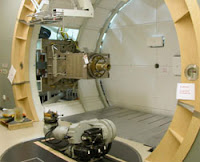 |
| The QNX-powered proton therapy system, or PTS |
Conventional radiotherapy may be potent, but it has a drawback. It can sometimes damage healthy tissue, and this damage can lead to secondary cancers later in life — a problem among children, who may live for many years after treatment and who are more likely to suffer from this side-effect.
There is, then, a real need to avoid radiating healthy tissue while maximizing the damage to the diseased tissue. And that's where proton therapy comes in.
Surgical strikes
Protons are relatively heavy, charged particles. They do minimal damage as they pass through tissue, but inflict significant damage where they stop. The challenge is to control the proton beams so that they stop exactly where you want them — the tumor.
Enter the QNX-powered proton therapy system (PTS) at the Indiana University Health Proton Therapy Center. Using the PTS, a radiotherapist can limit damage mostly to where the tumor is located. The radiotherapist can even "mold" the proton beam into the same shape as the tumor. This accuracy makes proton therapy especially useful for treating tumors located near vital organs. It can also reduce long-term effects sometimes associated with conventional forms of radiotherapy. And it serves as an alternative for patients who have already received other forms of treatment and have incurred damage to healthy tissue as a result — proton therapy can minimize the possibility that more healthy tissue is affected.
Delivering the right dose
The PTS uses the QNX OS in its dose delivery system (DDS) — think of it as the business end of the PTS. The DDS controls devices on the system’s nozzle (the beam transport and detection hardware closest to the patient) and measures dose-related values. The DDS also implements an energy-stacking scheme to obtain uniform depth-dose distributions.
The QNX OS allows the DDS to achieve very fast response times. For instance, if beam delivery must stop for any reason, the OS helps ensure that it stops immediately — and in this application, immediately is the only viable option.
I'm feeling appreciative
Before I let you go, a word of thanks to the folks at the proton therapy center. A year ago, I approached them out of nowhere with a proposal to do a video. Their response was overwhelmingly positive. They willingly gave of their time to discuss the proposal, explain what they do, and, of course, work with us on the video itself. While I'm at it, I'd also like to thank my friend and colleague Nancy Young for her fantastic work on this and all the other QNX videos she has produced in the last couple of years. (Speaking of which, have you subscribed to the QNX YouTube channel yet?)
No comments:
Post a Comment